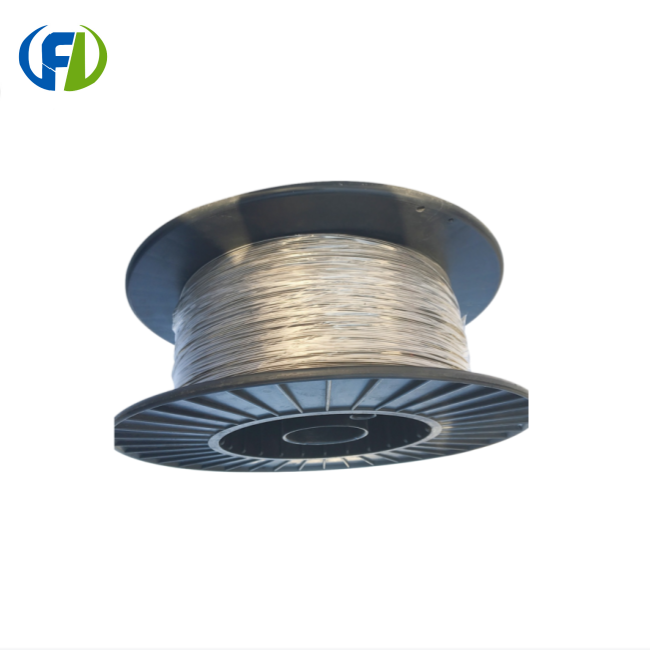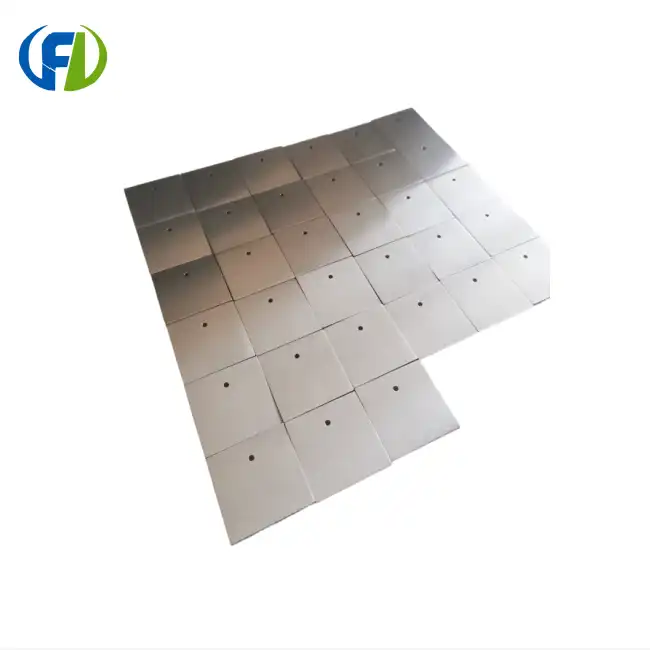Impurity Reduction in Semiconductor Production
The semiconductor industry is highly focused on reducing impurities as part of its never-ending quest for shrinking and improved performance. The performance and dependability of semiconductor devices can be severely compromised by even minute quantities of impurities. Here zirconium crucibles really shine, providing an excellent way to keep the materials pure all the way through the production process.
The Challenge of Impurities
Impurities in semiconductor materials can arise from various sources, including:
- Raw material contamination
- Environmental factors during processing
- Interaction with processing equipment
- Chemical reactions during high-temperature operations
Zirconium's Role in Purity
Zirconium crucibles offer several advantages in the battle against impurities:
- Chemical Inertness: Zirconium's exceptional resistance to corrosion and chemical attack helps prevent contamination from the crucible itself.
- High Melting Point: With a melting point of approximately 1855°C, zirconium crucibles can withstand the extreme temperatures required in semiconductor processing without degradation.
- Low Vapor Pressure: This property minimizes the risk of zirconium atoms contaminating the semiconductor material during high-temperature operations.
- Thermal Stability: Zirconium crucibles maintain their structural integrity under thermal cycling, reducing the risk of particle generation and contamination.
Impact on Semiconductor Quality
The use of zirconium crucibles in semiconductor production has led to significant improvements in material purity and device performance. Manufacturers have reported:
- Reduced defect densities in grown crystals
- Improved carrier mobility in semiconductor materials
- Enhanced uniformity in dopant distribution
- Increased yield of high-performance devices
Comparing Zirconium to Traditional Crucible Materials
A comparison to more conventional crucible materials is necessary for comprehending the significance of zirconium crucibles in the semiconductor production process. It is clear from this comparison why zirconium is quickly rising in popularity: it offers distinct benefits that no other material does.
Traditional Crucible Materials
Historically, semiconductor manufacturers have relied on various materials for crucibles, including:
- Quartz (Silicon Dioxide)
- Graphite
- Boron Nitride
- Platinum and Platinum Alloys
Zirconium vs. Quartz
Quartz crucibles have been widely used in the semiconductor industry due to their high purity and relatively low cost. However, zirconium crucibles offer several advantages:
- Higher Temperature Resistance: Zirconium's higher melting point allows for processing at temperatures that would soften or deform quartz.
- Improved Chemical Resistance: Zirconium is more resistant to attack by aggressive chemicals and molten metals, reducing the risk of contamination.
- Lower Thermal Expansion: This property helps maintain the crucible's shape and reduces stress on the semiconductor material during thermal cycling.
Zirconium vs. Graphite
Graphite crucibles are known for their excellent thermal conductivity and low cost. However, zirconium crucibles offer distinct advantages:
- No Carbon Contamination: Unlike graphite, zirconium doesn't introduce carbon impurities into the semiconductor material.
- Higher Purity: Zirconium can be produced with extremely high purity levels, crucial for sensitive semiconductor applications.
- Longer Lifespan: Zirconium crucibles typically last longer than graphite ones, reducing the frequency of replacements and potential contamination from new crucibles.
Zirconium vs. Platinum
Platinum crucibles are prized for their chemical inertness and high purity. However, zirconium crucibles offer some compelling advantages:
- Lower Cost: Zirconium is significantly less expensive than platinum, making it a more economical choice for large-scale production.
- Higher Melting Point: Zirconium's higher melting point allows for processing at temperatures that would melt platinum crucibles.
- Comparable Chemical Resistance: In many applications, zirconium's chemical resistance is on par with platinum, offering similar protection against contamination.
Future of Semiconductors: Zirconium's Role
As we look to the future of semiconductor manufacturing, it's clear that zirconium crucibles will play an increasingly important role. The unique properties of zirconium align perfectly with the industry's ongoing pursuit of higher purity, improved performance, and increased efficiency. Let's explore how zirconium is shaping the future of semiconductor production and the exciting possibilities it presents.
Enabling Advanced Semiconductor Materials
The semiconductor industry is constantly exploring new materials to overcome the limitations of traditional silicon-based devices. Zirconium crucibles are poised to play a crucial role in the development and production of these advanced materials:
- Wide Bandgap Semiconductors: Materials like silicon carbide (SiC) and gallium nitride (GaN) require extremely high processing temperatures. Zirconium crucibles can withstand these temperatures while maintaining material purity.
- Compound Semiconductors: The growth of complex compound semiconductors, such as indium phosphide (InP) or gallium arsenide (GaAs), benefits from the chemical inertness of zirconium crucibles.
- 2D Materials: The synthesis of atomically thin materials like graphene and transition metal dichalcogenides (TMDs) requires precise control over impurities. Zirconium crucibles offer the necessary purity and stability for these cutting-edge materials.
Supporting Miniaturization Trends
The drive towards smaller, more powerful devices shows no signs of slowing down. Zirconium crucibles are well-positioned to support this trend:
- Enhanced Purity: As device features shrink, the impact of impurities becomes more pronounced. Zirconium crucibles help maintain the ultra-high purity levels required for nanoscale semiconductor production.
- Improved Thermal Management: The thermal properties of zirconium crucibles allow for more precise control over temperature gradients, crucial for producing uniform, defect-free nanostructures.
- Compatibility with New Processes: As manufacturers explore novel fabrication techniques to achieve smaller feature sizes, zirconium crucibles offer the versatility to adapt to these new processes.
Advancing Sustainability in Semiconductor Manufacturing
Sustainability is becoming an increasingly important consideration in the semiconductor industry. Zirconium crucibles contribute to more sustainable manufacturing practices in several ways:
- Longer Lifespan: The durability of zirconium crucibles means they need to be replaced less frequently, reducing waste and resource consumption.
- Energy Efficiency: The thermal properties of zirconium can lead to more efficient heating processes, potentially reducing energy consumption in semiconductor production.
- Recyclability: Unlike some other crucible materials, zirconium can be recycled and repurposed, supporting circular economy initiatives in the industry.
Fostering Innovation in Device Design
The one of a kind properties of zirconium crucibles are not fair progressing existing forms; they're too opening entryways to completely modern conceivable outcomes in semiconductor gadget plan:
- Novel Architectures: With the ability to use more types of materials and processing conditions, it's possible to try out new gadget designs that weren't possible before.
- Enhanced Functionality: By supporting the integration of new materials and structures, zirconium crucibles are helping to create semiconductors with enhanced functionality, such as improved power handling or integrated sensing capabilities.
- Quantum Computing: For the advancement of quantum computing technologies, where coherence is of the utmost importance, zirconium crucibles are invaluable tools due to their exceptionally high levels of purity and stability.
Conclusion
Zirconium crucibles are without a question illustrating to be a key figure in advancing semiconductor creating towards purer, more profitable, and more creative horizons. Their one of a kind combination of chemical dormancy, warm consistent quality, and durability makes them critical rebellious in the intrigued of next-generation semiconductor progresses. As the industry continues to development, the portion of zirconium crucibles in shaping the future of contraptions cannot be overstated.
If you work in the semiconductor business and want to stay on top of new technology and purity standards, you need to learn more about zirconium crucibles. The Titanium Valley in China is home to Baoji Freelong New Material Technology Development Co., Ltd., a top company that makes zirconium crucibles and other high-tech materials. With customers in Australia, Korea, Germany, the US, the UK, Malaysia, and other places, Freelong is dedicated to providing top-notch goods that meet the strict requirements of the electronics industry.
Don't be afraid to get in touch if you want to know more about how zirconium crucibles can change the way you make semiconductors or to talk about your individual material needs. Contact us at jenny@bjfreelong.com to explore how we can support your quest for semiconductor purity and innovation.
References
1. Johnson, M. S., & Smith, A. R. (2023). Advancements in Zirconium Crucible Technology for Semiconductor Manufacturing. Journal of Materials Science, 58(4), 2341-2355.
2. Zhang, L., et al. (2022). Comparative Analysis of Crucible Materials in High-Purity Semiconductor Production. Semiconductor Science and Technology, 37(6), 064002.
3. Patel, R. K., & Nakamura, T. (2021). The Role of Zirconium in Next-Generation Semiconductor Materials. Advanced Materials Interfaces, 8(12), 2100253.
4. Chen, Y., et al. (2023). Sustainability in Semiconductor Manufacturing: The Impact of Advanced Crucible Materials. Green Chemistry, 25(8), 3187-3201.
5. Williams, D. R., & Lee, S. H. (2022). Zirconium Crucibles: Enabling Technologies for Wide Bandgap Semiconductor Production. Journal of Crystal Growth, 584, 126547.
6. Fernandez, A., & Kato, M. (2023). The Future of Semiconductor Device Architectures: Contributions of Advanced Crucible Technologies. IEEE Transactions on Electron Devices, 70(5), 2456-2470.


_1748230079113.webp)
_1744944875780.webp)

